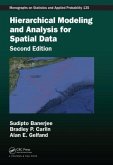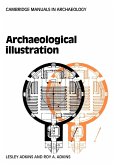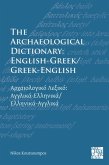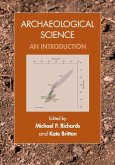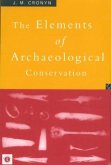Archaeological Spatial Analysis
A Methodological Guide
Herausgeber: Lock, Gary; Haciguzeller, Piraye; Gillings, Mark
Archaeological Spatial Analysis
A Methodological Guide
Herausgeber: Lock, Gary; Haciguzeller, Piraye; Gillings, Mark
- Broschiertes Buch
- Merkliste
- Auf die Merkliste
- Bewerten Bewerten
- Teilen
- Produkt teilen
- Produkterinnerung
- Produkterinnerung
Effective spatial analysis is an essential element of archaeological research; this book is a unique guide to choosing the appropriate technique, applying it correctly and understanding its implications both theoretically and practically.
Andere Kunden interessierten sich auch für
![Hierarchical Modeling and Analysis for Spatial Data Hierarchical Modeling and Analysis for Spatial Data]() Sudipto Banerjee (University of Minnesota, Minneapolis, USA)Hierarchical Modeling and Analysis for Spatial Data137,99 €
Sudipto Banerjee (University of Minnesota, Minneapolis, USA)Hierarchical Modeling and Analysis for Spatial Data137,99 €![Archaeological Illustration Archaeological Illustration]() Lesley AdkinsArchaeological Illustration47,99 €
Lesley AdkinsArchaeological Illustration47,99 €![The Archaeological Dictionary: English-Greek/Greek-English The Archaeological Dictionary: English-Greek/Greek-English]() Nikos KoutsoumposThe Archaeological Dictionary: English-Greek/Greek-English25,99 €
Nikos KoutsoumposThe Archaeological Dictionary: English-Greek/Greek-English25,99 €![Archaeological Science Archaeological Science]() Archaeological Science45,99 €
Archaeological Science45,99 €![Advances in Neutron Activation Analysis of Large Objects with Emphasis on Archaeological Examples: Results of a Coordinated Research Project: IAEA Tec Advances in Neutron Activation Analysis of Large Objects with Emphasis on Archaeological Examples: Results of a Coordinated Research Project: IAEA Tec]() International Energy AgencyAdvances in Neutron Activation Analysis of Large Objects with Emphasis on Archaeological Examples: Results of a Coordinated Research Project: IAEA Tec28,99 €
International Energy AgencyAdvances in Neutron Activation Analysis of Large Objects with Emphasis on Archaeological Examples: Results of a Coordinated Research Project: IAEA Tec28,99 €![Landscape and Settlement in the Vale of York: Archaeological Investigations at Heslington East, York, 2003-13 Landscape and Settlement in the Vale of York: Archaeological Investigations at Heslington East, York, 2003-13]() Steve RoskamsLandscape and Settlement in the Vale of York: Archaeological Investigations at Heslington East, York, 2003-1347,99 €
Steve RoskamsLandscape and Settlement in the Vale of York: Archaeological Investigations at Heslington East, York, 2003-1347,99 €![Elements of Archaeological Conservation Elements of Archaeological Conservation]() J.M. CronynElements of Archaeological Conservation49,99 €
J.M. CronynElements of Archaeological Conservation49,99 €-
-
-
Effective spatial analysis is an essential element of archaeological research; this book is a unique guide to choosing the appropriate technique, applying it correctly and understanding its implications both theoretically and practically.
Produktdetails
- Produktdetails
- Verlag: Taylor & Francis Inc
- Seitenzahl: 484
- Erscheinungstermin: 29. Januar 2020
- Englisch
- Abmessung: 244mm x 193mm x 30mm
- Gewicht: 1294g
- ISBN-13: 9780815373230
- ISBN-10: 0815373236
- Artikelnr.: 58598915
- Verlag: Taylor & Francis Inc
- Seitenzahl: 484
- Erscheinungstermin: 29. Januar 2020
- Englisch
- Abmessung: 244mm x 193mm x 30mm
- Gewicht: 1294g
- ISBN-13: 9780815373230
- ISBN-10: 0815373236
- Artikelnr.: 58598915
Mark Gillings is a Professor of Archaeology in the Department of Archaeology & Anthropology at Bournemouth University. His research interests concentrate upon the productive spaces that emerge through the integrated study of landscape, archaeological theory and digital archaeology, with a particular focus upon the potentials of all things geospatial and virtual. Much of his recent research has centred upon the prehistoric landscapes of south-western Britain, and the relationships that animated the complex, multi-scalar motleys of monumental structures and traces of everyday dwelling that characterise this region. Piraye Hac¿güzeller is a senior postdoctoral researcher at the Ghent Centre for Digital Humanities and the Archaeology Department of Ghent University. Her research interests are the theory and practice of digital archaeology and, more generally, digital humanities, specifically in the cases of geospatial data visualisation, management and analysis. She is the co-editor of a recent book on archaeological mapping, Re-mapping Archaeology: Critical Perspectives, Alternative Mappings (Routledge, 2018). Gary Lock is Emeritus Professor of Archaeology at the University of Oxford where he has spent 35 years teaching and researching several areas of archaeology. One of his specialisms is the British Iron Age, especially hillforts, and he was Co-PI of the Atlas of Hillforts of Britain and Ireland. His other main area of interest is computer applications in archaeology, especially GIS and spatial archaeology, in which he has published several books. He has recently retired as Chair of the Computer Applications in Archaeology conference.
List of figures. List of tables. List of contributors. 1. Archaeology and
spatial analysis. 2. Preparing archaeological data for spatial analysis. 3.
Spatial sampling. 4. Spatial point patterns and processes. 5. Percolation
analysis. 6. Geostatistics and spatial structure in archaeology. 7. Spatial
interpolation. 8. Spatial applications of correlation and linear
regression. 9. Non-stationarity and local spatial analysis. 10. Spatial
fuzzy sets. 11. Spatial approaches to assignment. 12. Analysing regional
environmental relationships. 13. Predictive spatial modelling. 14. Spatial
agent-based modelling. 15. Spatial networks. 16. Space syntax methodology.
17. GIS-based visibility analysis. 18. Spatial analysis based on cost
functions. 19. Processing and analysing satellite data. 20. Processing and
analysing geophysical data. 21. Space and time. 22. Challenges in the
analysis of geospatial 'Big Data'. 23. The analytical role of 3D realistic
computer graphics. 24. Spatial data visualisation and beyond. Index.
spatial analysis. 2. Preparing archaeological data for spatial analysis. 3.
Spatial sampling. 4. Spatial point patterns and processes. 5. Percolation
analysis. 6. Geostatistics and spatial structure in archaeology. 7. Spatial
interpolation. 8. Spatial applications of correlation and linear
regression. 9. Non-stationarity and local spatial analysis. 10. Spatial
fuzzy sets. 11. Spatial approaches to assignment. 12. Analysing regional
environmental relationships. 13. Predictive spatial modelling. 14. Spatial
agent-based modelling. 15. Spatial networks. 16. Space syntax methodology.
17. GIS-based visibility analysis. 18. Spatial analysis based on cost
functions. 19. Processing and analysing satellite data. 20. Processing and
analysing geophysical data. 21. Space and time. 22. Challenges in the
analysis of geospatial 'Big Data'. 23. The analytical role of 3D realistic
computer graphics. 24. Spatial data visualisation and beyond. Index.
List of figures. List of tables. List of contributors. 1. Archaeology and
spatial analysis. 2. Preparing archaeological data for spatial analysis. 3.
Spatial sampling. 4. Spatial point patterns and processes. 5. Percolation
analysis. 6. Geostatistics and spatial structure in archaeology. 7. Spatial
interpolation. 8. Spatial applications of correlation and linear
regression. 9. Non-stationarity and local spatial analysis. 10. Spatial
fuzzy sets. 11. Spatial approaches to assignment. 12. Analysing regional
environmental relationships. 13. Predictive spatial modelling. 14. Spatial
agent-based modelling. 15. Spatial networks. 16. Space syntax methodology.
17. GIS-based visibility analysis. 18. Spatial analysis based on cost
functions. 19. Processing and analysing satellite data. 20. Processing and
analysing geophysical data. 21. Space and time. 22. Challenges in the
analysis of geospatial 'Big Data'. 23. The analytical role of 3D realistic
computer graphics. 24. Spatial data visualisation and beyond. Index.
spatial analysis. 2. Preparing archaeological data for spatial analysis. 3.
Spatial sampling. 4. Spatial point patterns and processes. 5. Percolation
analysis. 6. Geostatistics and spatial structure in archaeology. 7. Spatial
interpolation. 8. Spatial applications of correlation and linear
regression. 9. Non-stationarity and local spatial analysis. 10. Spatial
fuzzy sets. 11. Spatial approaches to assignment. 12. Analysing regional
environmental relationships. 13. Predictive spatial modelling. 14. Spatial
agent-based modelling. 15. Spatial networks. 16. Space syntax methodology.
17. GIS-based visibility analysis. 18. Spatial analysis based on cost
functions. 19. Processing and analysing satellite data. 20. Processing and
analysing geophysical data. 21. Space and time. 22. Challenges in the
analysis of geospatial 'Big Data'. 23. The analytical role of 3D realistic
computer graphics. 24. Spatial data visualisation and beyond. Index.


